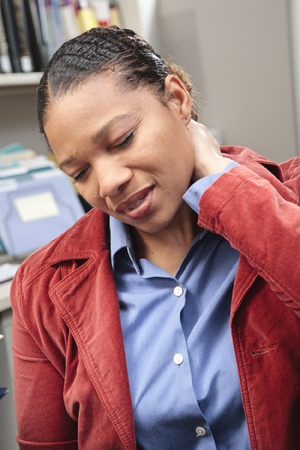Understanding Neck Problems
If you suffer from neck pain, you’re not alone. Many people have neck pain at some point in their lives. Problems, such as poor posture, injury, and wear and tear, can lead to neck pain. Your healthcare provider will work with you to find the treatment that’s best for your neck.
Types of neck problems

The following problems can cause pain or injury in your neck:
-
Strains and sprains. Strains (stretched or torn muscles) and sprains (stretched or torn ligaments) can cause neck pain. Strains and sprains can happen during an accident, or when you overuse your neck through repetitive motion. They can also cause your muscles and ligaments to become inflamed (swollen and painful).
-
Whiplash and other injuries. Whiplash can result when an impact throws your head, forcing your neck too far forward, then too far backward. When combined, the two motions can cause a painful injury to different parts of your neck, such as muscles, ligaments, or joints. The most common cause of whiplash is a car accident. But it can also happen during a fall or sports injury.
-
Weakened disks. A simple action, such as a sneeze or a cough, can cause one of your disks to bulge or rupture (herniate). A herniated disk can put pressure on your nerve and cause pain. Over time, disks can also thin out (degenerate). Flattened disks don’t cushion vertebrae well and can cause vertebrae to rub together. Also, there is less space for the nerves. This can pinch nerves and cause pain.
-
Weakened joints. Aging and injury can cause joints to slowly degenerate. Thinned joints can also cause vertebrae to rub together. This can cause abnormal growths of bone (bone spurs) to form on vertebrae. Bone spurs put pressure on nerves, causing pain.
Common symptoms
If you have a neck problem, you may have one or more of the following symptoms:
-
Muscle tension and spasm. You may not be able to move your neck, arms, or shoulders comfortably if you have muscle tension or stiffness in your neck. If your symptoms aren’t relieved, you may experience muscle spasms, or knots of contracted tissue (trigger points) in areas of your neck and shoulders.
-
Aches and pains. Dull aches in your head or neck, sharp pains, and swelling of the soft tissue of your neck and shoulders are common symptoms. If there’s pressure on the nerves in your neck, you may feel pain in your arms or hands.
-
Numbness or weakness. If you injure the nerves in your neck, you may have numbness, tingling, or weakness in your shoulders, arms, or hands. These symptoms arise when disks or bone spurs press on the nerves in your neck. Severe disease can also affect your legs.
Online Medical Reviewer:
Melinda Murray Ratini DO
Online Medical Reviewer:
Stacey Wojcik MBA BSN RN
Online Medical Reviewer:
Thomas N Joseph MD
Date Last Reviewed:
12/1/2022
© 2000-2025 The StayWell Company, LLC. All rights reserved. This information is not intended as a substitute for professional medical care. Always follow your healthcare professional's instructions.